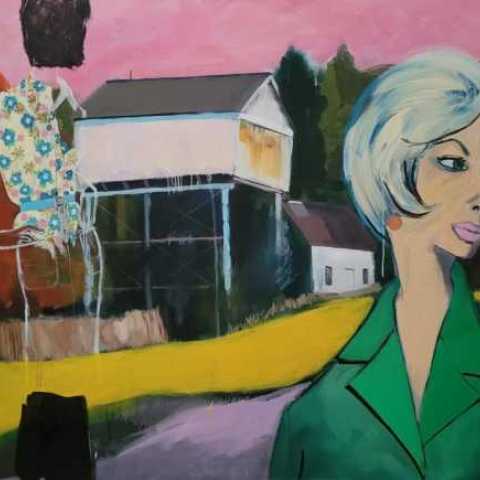Bermondsey Project Space
183-185 Bermondsey Street
London
SE1 3UW
United Kingdom

'Essere Umana: To be human' contrasts the eroticised female body with structures of isolation and abandonment. Bacon's practice juxtaposes images of pornstars and fashion models with neglected barns, obsolete war bunkers and derelict airfield buildings.
Josephine Bacon- "For many years the human body, specifically female, has been central to my work. Pornography, with the concept of the female body as an object or commodity, and popular notions of eroticism as manifested in advertising, top shelf magazines and internet porn have become subjects for exploration. Using a collection of tart cards found in telephone booths as a starting point I made a series of paintings of prostitutes. The format of the canvases – an elongated rectangle – echoes the proportions of a standard phone box. Each woman is contained within the space, often with limbs cropped, almost as though glimpsed through a half-open door. These women are not nudes in the tradition of life painting. They flaunt their bodies in soft-porn poses wearing bras and panties, stockings, sequined thongs, baby doll nighties. They may invite and provoke the male gaze but they gaze back with expression and agency.
In a deliberate move away from representations of the flesh I explored notions of isolation and desolation using images of abandoned water towers. Together with neglected barns, obsolete war bunkers, derelict airfield buildings, still bearing traces of humanity, they became totems in a desolate landscape, the forsaken water towers resembling angels guarding or watchful raptors scouring the bleak terrain for prey.
Eventually half-formed depictions of women, taken from magazine images, advertisements and sewing patterns were introduced. The sewing patterns evolved into a series that worked through a collection of dress patterns belonging to my late mother. The piece from the collection that inspired much of the work is the cover illustration for Simplicity 6970 showing six variations of one dress style. The models’ legs and faces had been scored and scribbled over with black biro with disturbing and sinister effect. They appear to have boxes or cages over their heads to conceal their faces. The original 1960s Simplicity pattern was easy to source and the heads of the models were revealed. This led to a series of portraits of the women. Through a process of obsessive drawing and painting each face acquired expression and became imbued with its own character.
The pattern pieces themselves are used in some of the drawings and paintings, either collaged onto the surface or as a painted representation of the paper piece. This was sometimes as a device to assert the flat surface of the canvas/paper, at other times they are stretched and distorted into ambiguous shapes. The boxes or head-covers appear too, as do the abandoned water towers; the womens’ bodies echoing their spindly structures, the box-heads mirroring the water tank atop the fragile stilt-like legs. Both melancholic emblems of desolation and dereliction.
The most recent work here, made in the last few weeks, sees a return to the tart cards with a series of large drawings on pink coloroll paper and gold printed wallpaper. The figures, often headless, are almost crammed into the rectangle, with little or no context, filling the space entirely. Their bodies seem to burst out of the paper, their nakedness emphasised by the luridly coloured scant pieces of clothing.
